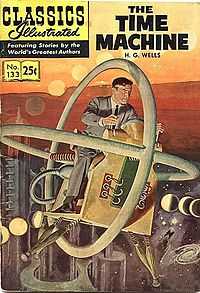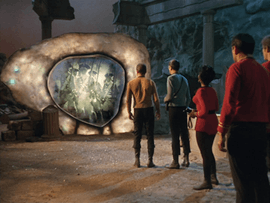Ronald Mallett
| Dr.Ronald L. "Ron" Mallett, PhD | |
|---|---|
| Born |
March 3, 1945 Roaring Spring, Pennsylvania, U.S. |
| Nationality | American |
| Fields | Quantum field theory, particle physics |
| Institutions |
Pennsylvania State University University of Connecticut |
| Known for | Time travel, quantum cosmology, relativistic astrophysics |


Ronald Lawrence "Ron" Mallett (born March 3, 1945) is an American theoretical physicist, academic, and author. He has taught physics at the University of Connecticut since 1975. He is best known for his scientific position on the possibility of time travel.
Early life and education
Mallett was born in Roaring Spring, Pennsylvania, on March 3, 1945 and grew up in The Bronx in New York City, New York. When he was 10 years old, his father died at age 33 of a heart attack. About one year later, at age 11, Mallett found a Classics Illustrated comic book version of H.G. Wells' The Time Machine. Inspired by this literature, he resolved to travel back in time to save his father.[1] This idea became a lifelong obsession and the basis of his research into time travel. Mallett served in the United States Air Force for four years, during the Vietnam War, as military service would aid his educational pursuits. He returned to civilian life in 1966. This was the year that the science fiction TV series Star Trek started, in which he "quickly became immersed". During its first season, Mallett watched the episode The City on the Edge of Forever that "involved both the theme of time travel and lost love", and this became his favorite of the entire series.[2]
In 1973, when he was 28 years old, Mallett received a Ph.D. from Penn State University. Also that year, he received the Graduate Assistant Award for Excellence in Teaching.[3]
Career
In 1975, Mallett was appointed a job as Assistant Professor at the University of Connecticut, where he continues to work today. His research interests include general relativity, quantum gravity, and time travel.
Mallett was promoted to Associate Professor and Professor in 1987. He has received two grants and many other distinctions.
In 2007, Mallett's life story of pursuing a time machine was told on This American Life, episode #324.
Time travel research
For quite some time, Ronald Mallett has been working on plans for a time machine. This technology would be based upon a ring laser's properties within the context of Einstein's Theory of Relativity. Mallett first argued that the ring laser would produce a limited amount of frame-dragging which might be measured experimentally, saying:[4]
"In Einstein's General Theory of Relativity, both matter and energy can create a gravitational field. This means that the energy of a light beam can produce a gravitational field. My current research considers both the weak and strong gravitational fields produced by a single continuously circulating unidirectional beam of light. In the weak gravitational field of an unidirectional ring laser, it is predicted that a spinning neutral particle, when placed in the ring, is dragged around by the resulting gravitational field."
In a later paper, Mallett argued that at sufficient energies, the circulating laser might produce not just frame-dragging but also closed timelike curves (CTC), allowing time travel into the past:[5]
For the strong gravitational field of a circulating cylinder of light, I have found new exact solutions of the Einstein field equations for the exterior and interior gravitational fields of the light cylinder. The exterior gravitational field is shown to contain closed timelike lines.
The presence of closed timelike lines indicates the possibility of time travel into the past. This creates the foundation for a time machine based on a circulating cylinder of light.
Funding for his program, now known as the Space-time Twisting by Light (STL) project, is progressing. Full details on the project, Mallett's theories, a list of upcoming public lectures and links to popular articles on his work can be found at the Mallett's UConn web page, and an illustration showing the concept on which Mallett has designed the time machine can be seen here.
Mallett also wrote a book entitled, Time Traveler: A Scientist's Personal Mission to Make Time Travel a Reality, co-written with author Bruce Henderson, that was first published in 2006. In June 2008, motion picture director Spike Lee's production company announced it had acquired the film rights to Mallett's book.[6] Lee is co-writing the movie script and directing the picture.[7]
In 2006, Mallett declared that time travel into the past would be possible within the 21st century and possibly within less than a decade. Mallett uses Albert Einstein's General Theory of Relativity to attempt to substantiate his claims.[8]
Criticism
In a paper by Ken Olum and Allen Everett[9] the authors claimed to have found problems with Mallett's analysis. One of their objections is that the spacetime which Mallett used in his analysis contains a singularity even when the power to the laser is off and is not the spacetime that would be expected to arise naturally if the circulating laser were activated in previously empty space. Mallett has not offered a published response to Olum and Everett, but in his book Time Traveler he mentions that he was unable to directly model the optical fiber or photonic crystal which bends the light's path as it travels through it, so the light circulates around rather than moving in a straight line; as a substitute he chose to include a "line source" (a type of one-dimensional singularity) which would act as a "geometric constraint", bending spacetime in such a way that the light would circulate around on a helix-shaped path in a vacuum[10] (for an older solution involving an infinite cylinder which creates CTCs, in this case due to the cylinder's own rotation rather than light circulating around it, see the Tipler cylinder). He notes that closed timelike curves are present in a spacetime containing both the line source and the circulating light, while they are not present in a spacetime containing only the line source, so that "the closed loops in time had been produced by the circulating flow of light, and not by the non-moving line source."[11] However, he does not provide any additional argument as to why we should expect to see closed timelike curves in a different spacetime where there is no line source, and where the light is caused to circulate due to passing through a physical substance like a photonic crystal rather than circulating in a vacuum due to the curved spacetime around the line source.
Another objection by Olum and Everett is that even if Mallett's choice of spacetime were correct, the energy required to twist spacetime sufficiently would be huge, and that with lasers of the type in use today the ring would have to be much larger in circumference than the observable universe. At one point Mallett agreed that in a vacuum the energy requirements would be impractical but noted that the energy required goes down as the speed of light goes down. He then argued that if the light is slowed down significantly by passing it through a medium (as in the experiments of Lene Hau where light was passed through a superfluid and slowed to about 17 metres per second) the needed energy would be attainable.[12] However, the physicist J. Richard Gott argues that slowing down light by passing it through a medium cannot be treated as equivalent to lowering the constant c (the speed of light in a vacuum) in the equations of General Relativity, saying:[13]
One has to distinguish between the speed of light in a vacuum, which is a constant, and through any other medium, which can vary enormously. Light travels more slowly through water than through empty space, for example, but this does not mean that you age more slowly while scuba diving or that it is easier to twist space-time underwater.
The experiments done so far don't lower the speed of light in empty space; they just lower the speed of light in a medium and should not make it easier to twist space-time. Thus, it should not take any less mass-energy to form a black hole or a time machine of a given size in such a medium.
Later, Mallett abandoned the idea of using slowed light to reduce the energy, writing that, "For a time, I considered the possibility that slowing down light might increase the gravitational frame dragging effect of the ring laser ... Slow light, however, turned out not to be helpful for my research."[14]
Finally, Olum and Everett note a theorem proven by Stephen Hawking in a 1992 paper on the Chronology Protection Conjecture,[15] which demonstrated that according to General Relativity it should be impossible to create closed timelike curves in any finite region that satisfies the weak energy condition, meaning that the region contains no exotic matter with negative energy. Mallett's original solution involved a spacetime containing a line source of infinite length, so it did not violate this theorem despite the absence of exotic matter, but Olum and Everett point out that the theorem "would, however, rule out the creation of CTC's in any finite-sized approximation to this spacetime."
Personal life
Mallett is a member of both the American Physical Society and the National Society of Black Physicists; his brother is artist Keith Mallett.
References
- ↑ Ronald Mallett 2012 THNKR interview
- ↑ Time Traveler: A Scientist's Personal Mission to Make Time Travel a Reality, by Ronald L. Mallett (pg59)
- ↑ http://www.phys.uconn.edu/~mallett/MallettCV.pdf
- ↑ R. L. Mallett, "Weak gravitational field of the electromagnetic radiation in a ring laser", Phys. Lett. A 269, 214 (2000). pdf
- ↑ R. L. Mallett, "The gravitational field of a circulating light beam", Foundations of Physics 33, 1307 (2003). pdf
- ↑ Time Traveler: A Spike Lee Film, Press Release June 16, 2008
- ↑ Spike Lee’s Time Traveler
- ↑ http://www.physorg.com/news63371210.html
- ↑ Olum, Ken D.; Allen Everett (2005). "Can a circulating light beam produce a time machine?". Foundations of Physics Letters 18 (4): 379–385. arXiv:gr-qc/0410078. Bibcode:2005FoPhL..18..379O. doi:10.1007/s10702-005-7127-4.
- ↑ Mallett, Ronald (2006). Time Traveler: A Scientist's Personal Mission to Make Time Travel a Reality. Thunder's Mouth Press. pp. 167–168. ISBN 1-56025-869-1.
- ↑ Mallett, Ronald (2006). Time Traveler: A Scientist's Personal Mission to Make Time Travel a Reality. Thunder's Mouth Press. p. 173. ISBN 1-56025-869-1.
- ↑ Brooks, Michael. "Getting In A Twist Over Time". Retrieved 2006-12-19.
- ↑ Holladay, April. ""...they can't come to us..," Carl Sagan". Retrieved 2006-12-19.
- ↑ Mallett, Ronald (2006). Time Traveler: A Scientist's Personal Mission to Make Time Travel a Reality. Thunder's Mouth Press. p. 205. ISBN 1-56025-869-1.
- ↑ Hawking, Stephen (1992). "Chronology protection conjecture". Physical Review D 46 (2): 603–611. Bibcode:1992PhRvD..46..603H. doi:10.1103/PhysRevD.46.603.
External links
- Mallett's UConn homepage
- R. L. Mallett, "Weak gravitational field of the electromagnetic radiation in a ring laser"
- R.L. Mallett "The gravitational field of a circulating light beam"
- Ron Mallett interviewed on Conversations from Penn State
- My Brilliant Plan - This American Life The episode contains a story about Ron Mallett's life goal of creating a time machine.
- A list of documentaries Mallett has been featured in
- Ron Mallett Penn State African American Chronicles profile and interview
- publications@ Astrophysics Data System
|